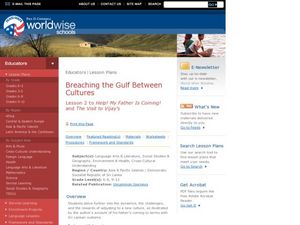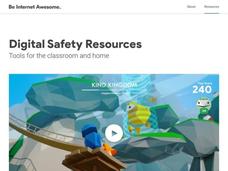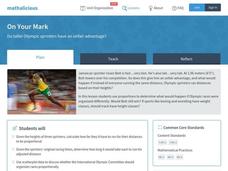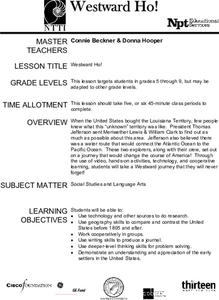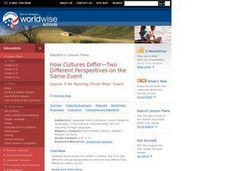Curated OER
Grocery Store Problem Solving
Fourth graders explore healthy eating habits by viewing instructional videos in class. For this food pyramid lesson, 4th graders identify the different classifications within the food pyramid and identify how they can improve overall...
Curated OER
Nineteenth Century Family Portraits
Students compare two nineteenth century family portraits using historical data, statistics, and historical context. Students analyze their own family pictures adjusting the criteria to the current decade. Lastly students study the...
Curated OER
Snowflake Fun
For this snowflakes fun worksheet, students identify and read about 5 different snowflakes illustrated on the sheet. First, they cut out each of the snowflakes on the rectangles where indicated to make finger puppets. Then, students use...
Curated OER
Breaching the Gulf Between Cultures
Students read excerpts from Jim Toner's memoir Serendib which chronicles his experiences as a Peace Corps volunteer in Sri Lanka. They work in small groups to analyze the excerpts and discuss how the author came to terms with Sri Lankan...
American Chemical Society
Production of a Gas - Controlling a Chemical Reaction
Though the publisher designated this unit for use with third through eighth grades, this particular lesson would be best used with middle schoolers due to the specific measurement skills required. Basically, they set up the reaction...
Exploratorium
Pupil
Give pupils a magnifier, a mirror, and a flashlight so that they can examine their own pupils. As they shine a light on their eyes, the light is shone on how this structure dilates and contracts to control how much is allowed into the...
Teach Engineering
Design Step 5: Construct a Prototype
Enough with the talking, let's build something! In the fifth step in the engineering design process, young engineers build a prototype to test their ideas. The lesson plan walks them through the process of evaluating it...
Teach Engineering
Design Step 6: Evaluate/Manufacture a Final Product
This is what all of the excitement has been building up to! Young engineers create engineering drawings, use machines to manufacture their products, test, and evaluate their designs in the last step in the engineering design...
Winkpass Creations
Knot Guide HD
Did you know that there are over 100 types of knots? Learn how to tie them all with this step-by-step, colorfully illustrated guide!
Mathalicious
On Your Mark
With many factors leading to a great athlete, does height make Usain Bolt unfairly fast? Middle schoolers conduct analysis to change the running distance of the Olympic races to be proportional to the height of the participants. They...
Curated OER
Civil Rights in America
Seventh graders visit the Smithsonian and are shown different exhibits. They are to make their own drawing about one of the exhibits and write about the experience.
Curated OER
History Fair
Students create a History Fair. They examine the National History Day Competition and are encouraged to participate.
Curated OER
Westward Ho!
For any teacher of American History, The Lewis and Clark Expedition is a watershed event that should be shared with your learners. This is a very good lesson on the Expedition, and the events that led up to it; including The Lousisiana...
Curated OER
How Cultures Differ "Two Different Perspectives on the Same Event
Students read excerpts from Peter Hessler's River Town: Two Years on the Yangtze and discuss his difficulties in learning the language, cultural clashes and how cultural perceptions shape our understanding of the world.
Curated OER
Make Your Own Temperature Scale
Differentiate between temperature and thermal energy. Your class will build a thermometer using simple materials and develop their own scale for measuring temperature. Discuss with your class and consider why engineers need to understand...
Curated OER
Figure of Speech
Examine the changing nature of language in the U.S. View and discuss excerpts from a PBS documentary with your class and then conduct Internet research, and complete a team project on the evolution of teen expressions.
SeaWorld
Animal Migrations
Here is a fabulous set of activities for your young scientists. Each lesson contains map, hands-on, and game activities that will help the class understand why and how animals migrate from one place to another. First they'll examine the...
Curated OER
Journalism: Underage Drinking
Students research underage drinking and read a report in the Journal of the American Medical Association about the issue. They interview experts on substance abuse and liquor store owners about their policies. Students publish their...
Curated OER
New York City Delights: The Taxi Cab
You set the rate! Step into the shoes of a taxi driver in New York City, and also pretend to be a person who uses taxis to get around town. The class will conduct collaborative research to learn about the history of taxis. Then, they...
Curated OER
Turn It Upside Down: Introduction to Computer-Aided Design
High schoolers explore a computer-aided design program. Students chart out roller coaster design, computer graphics and architecture. High schoolers focus on understanding the connections between mathematics, science, technology and...
Curated OER
How Dense is Salt Water?
Young schoolers explore the concept of linear regression. They determine the mass and density of salt water. Pupils add salt to water and record the density as salinity increases, and perform a linear regression on the data to model the...
Curated OER
Pre-Columbian Cultures in the Americas
Native American studies is fun, educational, and highly motivating. Fifth graders will gain a deeper understanding of the six major pre-Columbian culture areas on the North American continent. They will choose one group and conduct...
Curated OER
Is There a Limit to Which Side You Can Take?
Calculus learners find the limit of piecewise functions at a value. They find the limit of piecewise functions as x approaches a given value. They find the limit of linear, quadratic, exponential, and trigonometric piecewise functions.
Curated OER
Exploring Derivatives Using Lists
Learners explore lists and determine the derivative for that list. They use regressions to discover equations.



